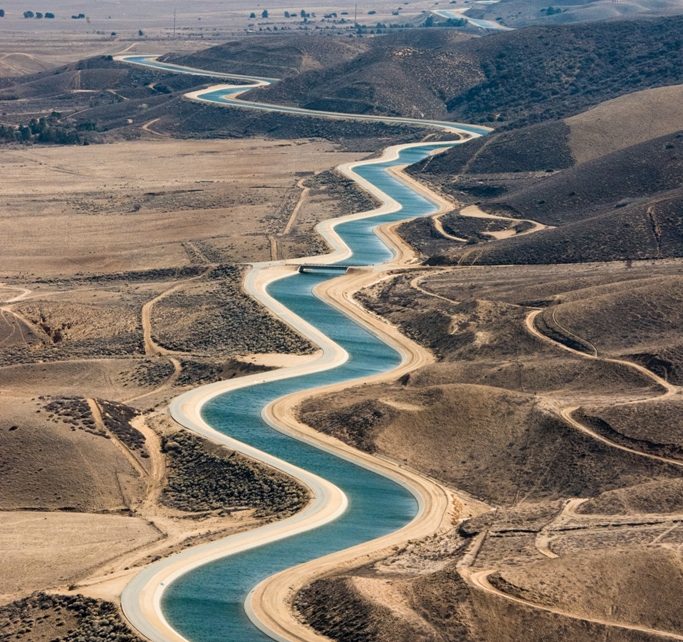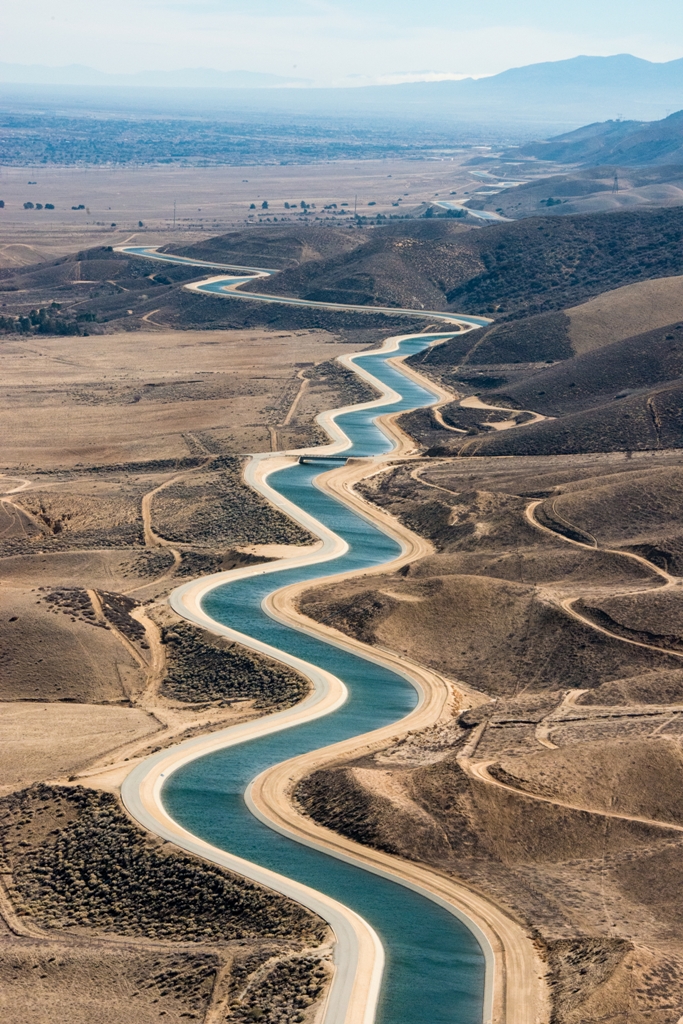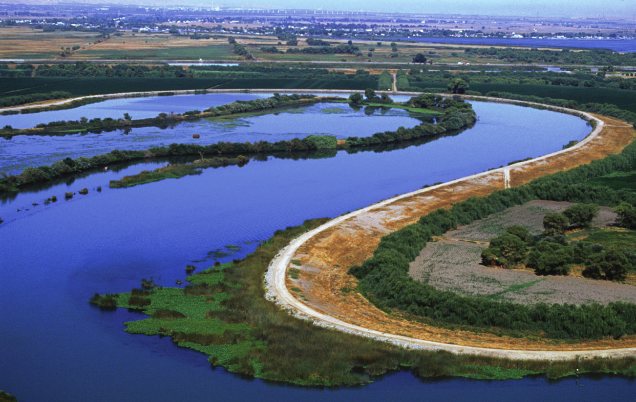
The California Aqueduct. (Photo: CA State Water Project)
Solving California’s Urban Water Scarcity
Why aren’t California’s water agencies investing more aggressively in runoff capture and underground storage?
By Edward Ring, March 31, 2021 2:15 am
A study by the Public Policy Institute of California in 2019 found that per capita urban water use in the state has dropped consistently over the years, from 231 gallons per day in 1990 to 180 gallons per day in 2010, then dropping to 146 gallons per day during the drought in 2015. This clearly bodes well for addressing the next drought, which could be on the way, but doesn’t address the challenges posed by suburban households with yards, which tend to use far more water than average.
In 2014, as Californians coped with the last severe drought, the Pacific Institute compiled data from the water districts serving urban consumers across the state in order to report per capita water use by region. The findings indicated that suburban households in the drier parts of the state were consuming water a per capita rate nearly three times the average; well over an acre foot per year per household.
Confronting this challenge addresses one of the key arguments of the anti-suburb movement: If every one of California’s 13 million households consumed an acre foot of water per year, residential water consumption in the state would be 13 million acre feet per year instead of the current 5 million acre feet per year.
There are many answers to this challenge, but exploring these answers, and the attendant policy solutions, should not merely rest on draconian restrictions on water use combined with a war on new suburban development. The other solution is to invest in infrastructure that guarantees water abundance even in drought years.
The advantages of this approach ought to be obvious: California is a so-called first world economy, with a standard of living that presumably should not submit to rationing. Californians should not have to worry about punitive fines if they take showers that last long enough to properly rinse the soap out of their hair. They should not have to wash their clothes in on-off high tech washers that take hours to complete a cycle and do a lousy job. They should be able to have a lawn if that is an amenity they value and are willing to pay a reasonable price to keep watered.
California’s suburbanites have a right to have these expectations. The economic cost to fulfill these expectations is manageable, as is the environmental impact. And by investing in infrastructure that creates water abundance in the state, a deep resilience is created that guarantees a secure water supply even during mega-droughts, or during civil emergencies where parts of the infrastructure are disrupted.
The principle that should govern suburban water use can be simple: They can use all the water they want if they’re willing to pay for it. Theoretically, there’s no reason why a suburban water consumer can’t bring their averages down to that of an apartment dweller: Stop all outdoor watering and let the plants all die, install low flow, water sipping appliances inside the house, and voila, you’re down to the magic 55 gallons per day per person or less. But you’re also creating a dust bowl, and living a diminished, micromanaged life. So how much should it cost a household, if they want to consume an acre foot of water per year?
The most expensive but inexhaustible source of fresh water is via desalination. The price to the consumer for desalinated water in California today is about one cent per gallon. That is on the high side, since developers of desalination plants have to withstand decades of regulatory delays and spend hundreds of millions on permits, fees, and litigation. Removing those barriers, along with tapping into new modular designs for desalination plants that do not require as much custom engineering, ought to be able to cut those costs in half.
As it is, however, at a penny per gallon, it would cost a household $3,258 per year, or $271 per month, to consume an acre foot of desalinated water per year. That should be the benchmark.
Keeping this price in mind has useful implications. It means that if local water districts are contemplating punitive rates for people who exceed their consumption targets, those rates should not exceed $.01 per gallon. It means that coastal water districts that are already billing their customers at a rate in excess of $.01 per gallon ought to be subjected to a withering audit of their operations. Desalination is frequently derided as a ridiculously expensive way to produce fresh water. Fine. If that’s true, then start charging people less for water sourced by other means. And other means are plentiful.
For example, treated wastewater in Los Angeles County is still discharged into the Pacific Ocean at the astonishing volume of over 1.0 million acre feet per year. All of this water was imported via aqueducts, primarily from the Sacramento River and the Owens Valley. As Orange County has demonstrated, as they are within a few years of recycling 100 percent of their wastewater to potable quality, creating drinkable water from wastewater can be done for roughly half the current price of desalination.
At the same time, storm runoff in the Los Angeles Basin requires treatment as well. Rain in Southern California is infrequent but often torrential when it does hit, washing toxins off impermeable surfaces and pouring them into the storm drains. All of this water should also be treated, with some of it reused and the rest discharged into the watersheds with the toxins removed.
These projects will cost billions of dollars. But by using the cost of desalinated water as a benchmark, it is clear that the ratepaying consumer can bear this cost. To the extent rates might go too high, general obligation bonds can pick up the slack. And what about developing less expensive sources of fresh water?
Why aren’t California’s water agencies investing more aggressively in runoff capture and underground storage, so that when the atmospheric rivers hit California – even in drought years there are a few of these – and dump far more water onto the state than the ecosystems require, millions of acre feet can be captured and stored for urban and agricultural use? Why weren’t the delta pumps running at full capacity back in January during what may have been the only big storms of 2021, sending water south to be stored?
The discussion of water policy as Californians face the possibility of another drought revolves around core issues, one of which is a huge political question: Are suburbs sustainable? The answer to this should be an emphatic yes. Families should be able to move to new, affordable suburbs. But to make this possible again, California must continue to invest in enabling infrastructure. Creating water abundance should be at the top of the list.
- Ringside: Saving California’s Rural Water Users - May 8, 2025
- Ringside: How to Add 10 Million Acre Feet Per Year to California’s Water Supply - April 30, 2025
- Ringside: Can EVs Make Up for Gasoline Shortages? - April 23, 2025







I’m really tired of reading about this water scarcity/drought dilemma. As best I can figure out, it is a man-made problem. TPTB can cause draught; they can cause rain and storms. Nobody has to have their water restricted. Weather has been weaponized. Get the water agencies, governor and the legislature to start programs to create rain and end droughts. Get the water agencies, governor and the legislature to stop programs that spray the skies to keep the drought continuing. Water abundance is something that the TPTB don’t want Californians to have and they want to tax the people more and control their behavior more — rather than admit they are the cause of the problem in the first place.
Papa88
A simple solution would be for the state of CA, would be to support the homeowners to dig a cistern for the millions of runoff to be captured to water the lawn etc. but more importantly to allow seepage for our aquifer. Most of our precious water runs off into the ocean.
The fact that no storage capacity has been built to match the population growth of re state since the 60’s is prima facie evidence that California legislators are either corrupt, stupid or both…
California is a net exporter of water to the Pacific Ocean. There is no shortage of water.